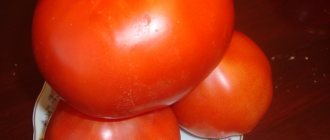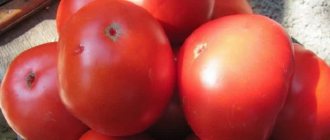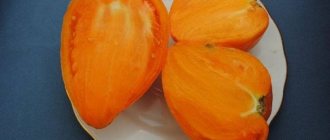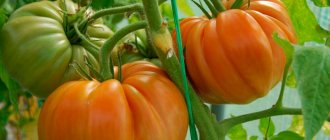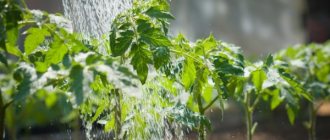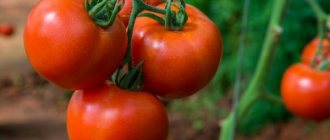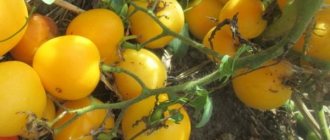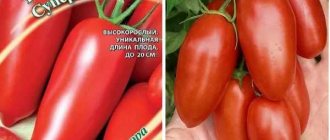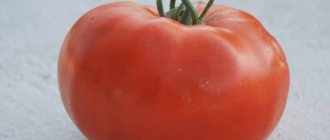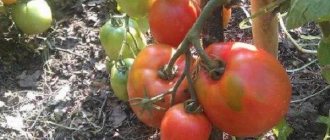Tomato Elisha will appeal to everyone who likes to grow tomatoes. The variety produces a relatively early harvest; the fruits are distinguished by their beautiful bright orange color and delicious taste. Recommended for feeding children and in medical nutrition diets due to the high level of valuable substances - carotenoids, lycopene, vitamins.
| Height | Landing location | Ripening time | Fruit color | Fruit size | Origin | Fruit shape |
| Medium height | Greenhouse, Open ground | Mid-season | Orange | Average | Variety | Plum-shaped or oval |
Description and characteristics of the variety
Tomato Elisey is a determinate medium-growing variety. Many stepsons are formed on the shoots, which are regularly removed. The bushes grow up to 1 m in height. The foliage and bushiness are significantly pronounced.
Description of tomatoes:
- average weight 50-60 g;
- the pulp is dense, moderately juicy;
- seed chambers 2-3 pcs;
- the taste is sweet with sourness;
- durable skin.
Ripening occurs in the middle period. Fruiting lasts several months. The crop is harvested 5 times during the growing season.
Features of cultivation and timing of planting seedlings
The best time for planting seedlings in warm regions of the country is considered to be the middle and end of February; in the temperate climate zone they are planted in the beginning or middle of March. The ripening period for seedlings is 65-70 days, so you need to focus on the climatic conditions of the region and the recommendations of the gardener’s lunar calendar. When planting seedlings in a greenhouse, it is recommended to carry out two feedings with humic fertilizers. After transplanting into open ground, feeding is required three times (in the hole, after the first flowers and after harvesting the first harvest), moderate watering is required, every 5-7 days.
On each bush, subject to all care conditions, up to 60 tomatoes can ripen at the same time. This requires removing the leaves to allow them to receive sunlight, and proper tying so that the fruit does not end up lying on the soil.
Tomato Elisha can be planted directly into the soil. To do this, the seeds are sown no earlier than the second decade at a shallow depth with a 50x40 pattern, fertilized with growth stimulants and covered with film. Picking is carried out at the level of 2 leaves.
Tomato Elisey
An early ripening variety, the period from germination to technical ripeness is 97-103 days. For growing in open ground and under film covers. The plant is determinate and requires staking and formation. The fruit is cylindrical, smooth, dense, orange. Weight 50-70 g. The taste of the fruit fresh, pickled and canned is excellent. An extended fruiting period will allow you to prolong the consumption of fresh fruits and their processing for future use for a longer period. Due to the fact that the variety is cold-resistant, earlier planting of plants in the ground is possible.
How to grow
The Yenisei tomato must be grown using seedlings.
To begin with, the seeds need to be placed in an aloe solution for a short time, and then sown in the soil to a depth of one centimeter. When sowing is complete, it is necessary to water the seeds every day with warm water from melted snow or rain (optional, but desirable) and after watering, cover the area with film until the first sprout appears. In order for growth to proceed steadily, you need to sometimes add compost extract. The Yenisei tomato loves light, so using fluorescent lamps you can speed up plant growth. When two leaves of the seed appear, they need to be planted in different peat vessels. All these actions will help protect the roots of the tomato from various injuries. Planting seedlings can begin in the first ten days of the last month of spring, the order of their placement is like in chess.
According to the research and practice of gardeners, the best fruitfulness of the Elisha tomato is established when the bush matures into one or two stems.
tomato Don Juan - description and characteristics of the variety
Advantages and disadvantages
Considering that Artist f1 is a favorite of greenhouses and shelters, you can talk a lot about him for a long time. The main advantages of this hybrid include the following indicators:
- Early ripeness. The first fruits ripen already 102-110 days after germination.
- In greenhouses, the plant can grow more than 1.5 meters and produce at least 8 bunches of excellent fruit.
- There are 5-8 fruits in the cluster, with a total weight of 0.750 to 1.200 kg.
- The fruits are the same size, 140-150 grams, bright scarlet in color without green. These indicators make the hybrid competitive in the vegetable market.
- Excellent transportability and taste.
- Possibility to grow tomatoes with one or two stems.
- A long harvest period, which allows the fruits to be consumed fresh until late autumn.
- The ability of fruits to be stored for 30 days without any significant changes in taste.
- High immunity to many diseases. This allows you not only to save on expensive protective equipment, but also to obtain higher quality products at lower costs.
Artist f1 does not have many disadvantages, the main ones are:
- Growing only indoors.
- The need for a garter.
- Fruit density. This indicator is an advantage when transporting and processing tomatoes, and a disadvantage when consuming them fresh.
Reviews
- Victor, gardener from the Moscow region, the city of Khimki: The variety is very tasty. It's easy to care for. And the fruits ripened evenly, large, deep red and shiny. The pulp is made of small grains, soft and juicy. They were stored for a long time, but due to their thick leather there were no scratches or cracks on them. They can simply be stored in a not very warm storage facility.
- Ira, a summer resident from the Sverdlovsk region, the city of Dir.: I planted this variety after I tried my friend’s tomatoes and was completely delighted and shocked. I have never seen or eaten such delicious tomatoes! I grew several bushes in a greenhouse, they grew tall with many powerful branches. The variety is not susceptible to disease; it has withstood fungus, late blight and blossom end rot. It is best to use the Yenisei in salads or canned foods, roll it into jars, cut it into slices with spices, onions and garlic, I can say that it is one of the best dishes I have eaten.
- Valentinovich, gardener from the Vladimir region, the city of Vladimir: I was interested in the Yenisei variety, when I read its characteristics on the Internet, what interested me most was that the fruits ripen in large quantities and have a rich red color, I like it. I planted them first in the greenhouse, installed the entire bush on one stem and fertilized them with humus. After waiting for the fruits to ripen, I was very surprised that the Internet was telling the truth, there really are a lot of tomatoes, I collected from four hundred to five hundred grams. And most importantly, not a single rot was found. And, of course, the taste is amazing, whether fresh or canned.
We invite you to familiarize yourself with: Potato breeze: characteristics and description of the variety, cultivation and care
tomato Druzhok - description and characteristics of the variety
Tags: Elisha, description, variety, tomato, characteristics
About the author: admin4ik
« Previous entry
My favorite tomato varieties
January and February are the right time to select and purchase tomato seeds, which we will sow in March. I have been growing tomatoes in a greenhouse and in open ground for only 6 years, but I have already managed to create my own hit parade of tomato varieties.
READ MORE: Detailed description and characteristics of the Nastenka apple tree variety
There are must-have varieties that I always plant every year. I like them not only for their taste and unpretentiousness, but also for the way they look on the bush. I’ll paraphrase one bearded joke: “I don’t really like tomatoes... But the process itself...”. I love going into the greenhouse and admiring the tomato plantations. And I don’t hesitate to show off my particularly spectacular huge tomatoes to my neighbors, and then post photos on the forum. It’s a shame to hide it – we all love it!
The following varieties are among the favorites also because they do not need to be fanatically cultivated and shaped. And they will always give a harvest: small, large, and a lot, depending on the variety and what I grow them for - for salads, for preparations, or, the smallest and sweetest ones, so that “like seeds, they click.” .
The “Rocket” variety is suitable for both greenhouses and open ground. The fruits are identical in shape and sweet. We love to eat them by the handful. Look good in blanks. The bush requires garter, despite the fact that the package says the opposite. This is because a lot of fruits grow, and the bush bends from the weight. Its height in open ground is about 40 cm, and in a greenhouse it can reach up to 60 cm. This is a mid-season variety; it does not need to be pinched.
Rice. 1. “Rocket” matures smoothly and is well stored in both technical and biological maturity.
I got the “Big Man” variety from a neighbor. During a tour of her greenhouse, I really liked the way it looked on the bush. The neighbor said that she has been planting it for a long time, that it is unpretentious and always sets fruit, even if the ventilation regime in the greenhouse is not followed. Of course, I took one fruit for seeding. “Zdorovyak” can grow up to 100 cm in height, so it is better to grow it in a greenhouse, although it produces large tomatoes in open ground.
Rice. 2. There is almost no need to pin the “Big Man” wrist.
Rice. 3. It ripens in batches, gradually, which is very convenient.
Among the vigorous-growing tomatoes with large fruits, I singled out the “Red Giant” variety. This amateur variety was bred by simple gardeners. Despite the fact that it grows a lot of leaves, it does not have to be pruned too often. The fruits on the lower tiers are the largest. If I had not been lazy and plucked out the inflorescences, leaving no more than 3-4 in the brush, the fruits would have been even larger. It is fleshy inside and contains few seeds.
Rice. 4. “Red Giant” in mid-July.
Rice. 5. You can take your own seeds, but the fruit must ripen on the bush and come from the second cluster from the bottom.
Rice. 6. The fruits are slightly ribbed, quite transportable, there is never a yellow-pink top from unbalanced care, as in pink-fruited varieties.
Rice. 7. Both the side of the stalk and the reverse side always have a marketable appearance.
Rice. 8. The only drawback of the “Red Giant” is that the largest fruits require a garter.
However, almost all large-fruited tomatoes require additional tying of the brushes. Except for my next favorite, Bull's Heart. I also always grow it year after year, as my grandmother advised me. “He will never let you down!” - she said, and every year I am convinced of this. Even if I took my own seeds and not factory ones, “Bull’s Heart” invariably bears fruit and does not require pinching at all, although it is vigorous.
Rice. 9. The hands grow in such a way that they do not need to be additionally secured with a garter to prevent them from falling.
Rice. 10. There is one peculiarity of the “Bull’s Heart” - a predisposition to the formation of such gnarled fruits.
Therefore, if you see a bud or flower that is too large, feel free to cut it with scissors, it will still take a long time to ripen, even though it will be large, the skin will be hard and gray, you cannot take seeds from it.
Rice. 11. But the bulk of the “Bull’s Heart” fruits are very beautiful, tasty and fleshy. By the way, this variety comes in both orange and red.
I definitely plant the listed varieties, but there are also some that I just liked, and I periodically grow them in the greenhouse, but I have not become a fan of them. Of the indeterminates, I like the raceme varieties the most. Again, this is primarily because they look beautiful on the bush. There are only three varieties, and each has a special reason to grow it.
“Intuition F1” is a mid-season hybrid, but I would classify it as a late-season hybrid. Not only does it reach harvest ripeness only by mid-August, but biological maturity also comes quite late. Some specimens of these tomatoes ripen even until the end of October. But, on the other hand, this is convenient because as a result, we have our own fresh tomatoes at home for a very long time. That's why I sow it in February.
Rice. 12. Photo from the end of July, but the fruits have not yet begun to ripen.
But “Intuition F1” is very easy. This hybrid is great for freezing for future use. In winter, I make pizza and frittata with them, as they do not defrost like porridge, but retain their meatiness well when cut.
READ MORE: Tomato Marianna f1 description and characteristics of the variety, yield with photos
Rice. 13. The fruits are all smooth and beautiful.
Rice. 14. In this form, I send “Intuition F1” to deep freeze.
“Scarlet Candles” is a cluster variety, mid-season. They don’t have a special taste, but what a shape! Looks impressive in preparations with cucumbers. However, this is why I grow them. It’s nice to admire such a jar later in the winter.
Rice. 15. The length of “Scarlet Candles” is almost like pickling cucumbers.
Rice. 16. “Scarlet candles” look neat, they all have a characteristic “spout”.
“De Barao” is quite late-ripening; I sow it earlier than the bulk of tomatoes. I really like it in preparations, it does not crack and is very tasty, both fresh and pickled.
Rice. 17. "De Barao" is resistant to disease. I always plant it on the north side, tying it above the entrance to the greenhouse, because it is very tall, and the upper tier ripens even in the last ten days of August, despite the first cold nights.
Rice. 18. The fruits are beautiful, all as one.
I have tried a great variety of salad varieties, I still want to find the most delicious one. Of the unusually colored tomatoes, I really like the taste of “Malachite Box” and “Black Prince”. Both are tall and require pinching, gartering, and formation into 1-2 stems, but the effort is worth it, the fruits are magnificent. “Black Prince” is dark burgundy when fully ripe.
Rice. 19. “Malachite box” in biological maturity – green.
Rice. 20. All these “Malachite Box” tomatoes are already ripe, although in appearance they seem unripe.
The yellow giants are not inferior in taste, of which the most fleshy and tasty for me are “Yellow Truffle” - of an unusual shape, “Persimmon” - indeed, the pulp is cut like the fruit of the same name, “Golden King” and sweet like a melon, “ Golden Bull." “Golden Heart” and “Altai Yellow” were less impressive. But it should be noted that the shelf life of yellow tomatoes is inferior to red ones.
Rice. 21. Everyone looks the same on the bush. This is Cardinal.
Rice. 22. “Cardinal” is well kept.
Rice. 24. In the foreground is “Mazarin”. It differs only in shape, in taste - like all other red-fruited ones.
Rice. 25. “Altai Reds”, however, can be praised for their friendly maturation.
Separately, I would like to mention the pink-fruited tomatoes “Miracle of the Earth”. If you are lucky with the summer and it is not very hot, then you can get a good harvest from this variety.
Rice. 26. “Miracle of the Earth” are also tall.
But, if there is not very good ventilation in the greenhouse, then this variety will give a characteristic light yellow border, I don’t like it, and I cut it off before use.
Rice. 27. “Miracle of the Earth” - on the right. They are the same size as the Red Giant on the left.
Separately, it should be said about tall cherry tomatoes, for example, “Chio-chio-san”, “Sweet Cherry F1” and others. Yes, many of them are sweet, they look elegant both in the greenhouse and in pickles, but many of them are thrown away and require careful care. No matter how much I refuse to plant them, I still “break down”, I really want to admire the brushes.
Rice. 28. “Red date” is, of course, delicious.
Rice. 29. “Goldilocks” also tastes good if you resist and don’t eat it half-ripe - and it can be eaten even half-ripe.
Among the tomatoes for growing outside, I liked only five. Although all tomatoes for open ground can be grown in a greenhouse, if there is space. It is simply more efficient to occupy a greenhouse not only in width, but also in height, so it is customary to place low varieties outside, under temporary shelter or without it at all.
The hybrid “Market King III F1” got its name for a reason. I grow it under cover and without, depending on how much space remains in the greenhouse after the main plantings. It is considered early ripening, although I would not say so. I plant it with pleasure, because in any summer - both cloudy and hot - it produces a stable harvest.
Rice. 30. “Market King III F1” produces aligned fruits (in the red basket).
Rice. 31. “Apple tree of Russia” on a bush.
Rice. 32. “Apple Tree of Russia” stores well, including when frozen.
Rice. 33. “Buyan” is a long-known trouble-free variety for open ground.
Rice. 34. “Buyan” is good for pickling.
Rice. 35. I bought “Leningrad Chill” in economical packaging - 200 seeds in one. It lived up to its name, did not freeze during frosts, and grew well both in the greenhouse and outdoors.
Rice. 36. But the yellow-fruited variety “Wonder of the World” turned out to be the most cold-resistant for open ground. It sets an incredible amount of fruit.
From the low ones I also tried “Kremlin F1”, “Peach”, “Orange Sun”, “Dushechka”, “Tiger”, “Sanka”. Despite the hype, these varieties disappointed me.
READ MORE: Ideas for a lazy garden: choosing a style and unpretentious plants
Tomato Elisey
Description and characteristics of the Elisha tomato variety, reviews, photos
Early ripening (97-103 days from germination to ripening), determinate, unpretentious, cold-resistant, pickling tomato variety for open ground and film shelters.
The bush is undersized and requires tying to a support and partial pinching. Medium sized leaf, light green. The inflorescence is simple.
Basic qualities of fruits
The fruits are cylindrical, smooth, dense, orange in color at maturity, weighing 50-70 grams, good taste (for early ones). These tomatoes are ideal for pickling and canning, and are also suitable for fresh consumption and processing.
The variety has an extended fruiting period. Resistant to verticillium wilt and fusarium wilt.
The Elisha tomato variety is included in the State Register of the Russian Federation for cultivation in open ground and under film covers.
Features of cultivation
We recommend sowing the seeds of this tomato variety for seedlings 60-65 days before the intended planting in the ground. Seedlings dive at the stage of two true leaves. When planting seedlings in a permanent place per 1 sq. It is recommended to place up to 4 plants per meter of land. Planting pattern 50 x 40 cm
Further care for tomatoes consists of timely watering, fertilizing with complex mineral fertilizer, pinching and preventive measures to protect against diseases and pests.
If you grew Elisha tomatoes, please write whether you liked them or not. What was the yield and taste of the fruit? Has this variety become your favorite? Briefly describe the advantages and disadvantages of this tomato in your opinion. If possible, attach a photo of these tomatoes to your comment. Thank you!
Your feedback on the Elisha tomato and additions to the description will help many gardeners evaluate this variety more objectively and decide whether it is worth growing or not.
